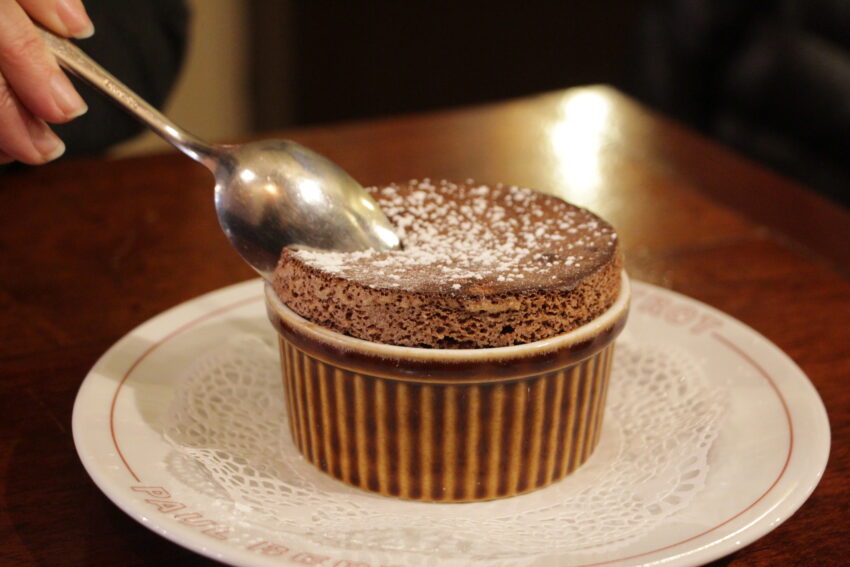The first time I tried to go to le Bistrot Paul Bert, I was living on the other side of the city, in the 13th. In a time before Instagram and widespread “best of” lists, this bistro was at perhaps the pinnacle of its popularity among Americans, touted by star chefs from our side of the Atlantic and known and beloved above all for its steak au poivre. I had reserved a table for myself and my then-boyfriend, a steak-eater if ever there was one (though now, oddly, a vegetarian.)
Upon arriving at the bistro, however, I found that I had accidentally made a reservation at the seafood outpost l’Ecailler du Bistrot next door. It was fine, but my mistake had left a bitter taste in my mouth.
My next visit was more successful, this time with my little sister on the eve of her departure after four months of living with me in Paris. The tiled floors and red leather chairs lent the bistro exactly the classic ambiance I had been hoping for to bid her au revoir, and I still remember, a decade later, the succulence of that steak, the rich, pepper-studded cream sauce, those perfectly golden frites.
My most recent return came at the tail end of a veritable bistro marathon, where I visited some of Paris’ best, from time-tested Chez Georges to newcomer Bistrot des Tournelles to neo-bistrot Au Petit Panisse. I was curious to see if this bistro, whose qualities have made it a favorite of such famous foodies as Dorie Greenspan, Ina Garten, and David Lebovitz, would live up to the hype.
I visited on a Tuesday at lunchtime to find that while far from empty, the bistro certainly wasn’t as bustling as it had been on my last dinnertime visit. I’d secured a reservation fairly easily, which is important to note, seeing as for a while there, I’d heard they were barely answering the phone.
Service was assured, at least in my nearly-empty dining room – one of three – by an efficient waitress who even offered a smile or two but outright refused to speak English to a neighboring table of Americans who bumbled their way through the ordering experience laudably. Over complimentary gougères – cold, but still delicious – my dining companion and I deliberated over our choices: appetizers like house-made charcuterie (10) or smoked herring (14) but also truffled fried eggs (28) or truffled croque monsieur (35); mains ranging from saucisse-purée (26) to sole meunière (54 for one, 85 to share).
I ultimately decided to opt for the lunchtime formule, a steal at 22 euros for two courses or 26 for three. The egg-mayo toyed slightly with tradition, the eggs nestled in a bed of perfectly fine potato salad and served alongside a salad with a bright, zingy vinaigrette and a few threads of raw chiogga beet. I liked the shallot in the salad and the house-made mayonnaise; I was less a fan of the eggs themselves, which had been hard-cooked until a grey ring formed around their chalky yolks. (They should call up former vice-champion of the best egg-mayo in Paris contest, Chris Edwards. After he shared his secret to the perfect boiled egg with me, I’ve never had a flop.)
My main was far more successful: a thick slab of roast pork paired with stewed prunes and sautéed savoy cabbage. The pork itself was fine, if a bit dry, though it was richly flavored, and the fatty parts in particular married perfectly with the sweet, tender prunes. The real winner of this plate was actually the cabbage, which was studded generously with black peppercorns and cooked perfectly until it nearly melted but boasted no lingering sulfurous quality.
My friend opted for the dish that had remained so indelible in my memory: the steak au poivre (44). A thick medallion of tenderloin is generously coated in sarawak pepper before being doused in a cream sauce seasoned with more of the same. She generously let me steal a bite (OK… two bites) off her plate, and I can confirm it’s just as delicious as it always was.
So too, for that matter, are the golden frites, with the perfect marriage of crispy exterior and fluffy, airy interior. (She shared these with me too. For science, obviously.)
In return, she helped me out with this chocolate soufflé, a generous portion, especially for lunchtime.
Unfortunately, despite its towering beauty, this fell a little flat for me: a little too liquid, a little too mild in chocolate flavor.
Far better was the eggy cannelé that accompanied the espresso, which was also delicious. (And at 3.50, it certainly should be.)
Le Paul Bert is a good bistro; this I cannot deny. But is it worthy of all of the accolades? Of that I remain uncertain. The dining room is beautiful and authentic, the ambiance genial. The food, when good, is very good, but I cannot say it’s any better – or even, for that matter, as delicious – as the food at similarly charming, similarly priced Bistrot des Tournelles or Chez Georges.
All in all, if invited, I would surely return to le Paul Bert, and happily. I would order the steak au poivre and luxuriate in that rich cream sauce, pairing it with one of the wines from the list so long so lovingly cultivated by founder Bertrand Auboyneau. But this bistro has a more than big enough, more than loud enough fan club to need my little voice, which, when given the chance, will instead lend its vote in favor of somewhere that hasn’t had the attention of quite so much star power – and thus might offer more masterful approaches to the classics that here ultimately just barely miss the mark.
Bistrot Paul Bert – 18, rue Paul Bert, 75011










